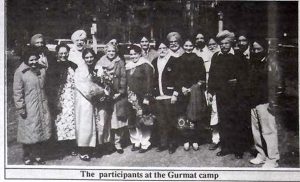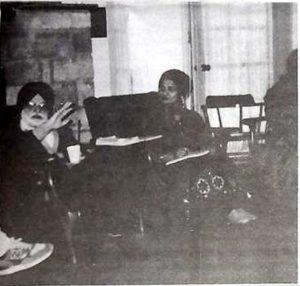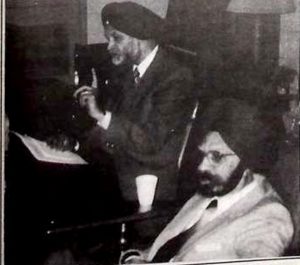
LEWISBURG: A week-end retreat was organized by Prof. Balwant Singh of Bucknell University to bring together a wide Variety of talented Sikhs representing academics, art, music, literature, science, Political Science, education, social work and medicine. A group of over 30 men and women got together to take stock of the social and political realities as they influence the lives of the “first generation” of Sikhs Professionals who are now reaching the age where retirement is an Overriding issue. They were joined briefly by the Sikh youth to spell out their needs and concerns about the role of Sikhs in North America in the 21st Century.
The participants left a part of themselves at the Bucknell University Brown Conference Center,
With a fond hope that such forums will continue to be held on a regular basis-at least twice a year. Closing day of the camp which started with the morning prayer –Nit Nam was followed by singing of Gurbani Shabads in classical style by Sardami Manjit Kaur as the “sun peered through the glass doors. Faces lit with the joy of Gurbani sung in the ragas in which the “Gurus had uttered them became ‘somber as Prof. Gurcharan Singh ‘of New York University gave a Poetic account of the tragedy of Punjab, and we all wept for the young Sikh women mothers, sisters and wives of the newly wed, living in Punjabi villages and their losses of the loved ones at the hands of the security forces of India. Sikh history was reviewed, and Sikh tradition of martyrdom was cited to put things in proper perspective.
A coherent, logical case for a Sikh homeland was discussed thereafter, The current activity of Amnesty International in highlighting India’s abuses of human rights received careful attention. It was recommended that Sikhs should receive copies of the Amnesty International’s report and arrange to widely disseminate particularly to newsmakers, reporters, politicians and civic leaders. It was also recommended that we should think of creating organized channels of communication with the families being affected by the daily killings of Sikh youth in Punjabi villages, in order to help the surviving members to send them financial help for education of their children.
Previous discussions were aimed at defining needs of Sikhs living in North America, and the role of Sikh youth in the 21st Century. Time and again, we were brought back to Sikh history and tradition, and Dr.Balwant Singh, very aptly quoted from Gurbani to help us understand the current situation in light of the fundamentals of Sikhism and our rich spiritual heritage. This camp, in fact, was a workshop which focused on how to interpret the poetry of Gurbani and its language into meaningful modem idiom. It was felt that we need to focus on producing literature in English for non-Punjabi speaking youth, to give them a taste of the poetic excellence and spiritual heights of Guru Granth Sahib. Several hours were spent on discussing the needs of Sikhs living outside India, particularly the young who are growing up in this country. While the traditional functions of the Gurdwaras were recognized as fundamental, new directions need to be charted, particularly in the training of grant his, in organizing symposia and discussions on topics of contemporary relevance, in developing programs which can open a dialogue with other religions as well, and in areas which allow our young people to grow up as good Sikhs here in a predominantly non Sikh milieu. It was pointed out that such a discussion would be more meaningful if held in a gurdwara or where many of the people involved in gurdwara management could participate, Among the youth members present, Suneet Kaur was especially vocal about her dissatisfaction with the way Gurdwaras were being managed. “Youth are not being involved in Gurdwara affairs, nor are the Sunday programs geared towards the needs and interests of youth,” she said. There was a consensus among the group about the need to change the way Gurdwaras management teams were elected; a greater involvement of youth in gurdwara management could bring better management skills, along with their idealism and zest for honesty and their future orientation, “The elders should let go of the power from their hands, so that youth could take over the Gurdwaras by the turn of the century,” was the joint opinion of the group.
There is a strong need to hold a national convention, to reassess the role of Sikh institutions especially Gurdwaras, in order to educate the generations in their spiritual heritage, and to utilize the potential of older men and women in revitalizing the institutions with true spirit of Sewa so uniquely ingrained in our Sikh way of life.
The discussions were free, frank and stimulating. The desire to see such forums continue on a regular basis was overwhelming. The location was idyllic, the weather cooperated, and the change from daily routine was exactly as needed, and minds were in tune with the richness of beauty of nature, where the Sikh tradition and heritage were brought into full play during this week-end retreat.
True meaning of Sewa was evinced by the team headed by Sardarni Brimal Kaur, which worked almost round the clock to provide meals, tea and snacks when discussions went on until after midnight. Brig K.J. Singh and Mrs. Ninal .J. Singh were more than willing to keep the supply line running smoothly. Our thanks to this gracious team and Birnal, who received a bouquet of red roses which she proudly held in her arms while Sardar Harbhan Singh of the World Bank and I drove away from the Brown Conference Center in the midst of tall trees.
As I looked at the glimmering waters of the placid river alongside the road between Washington D.C. and Lewisburg, i thought of the Sikh Youth struggling in Punjab, the land of fine rivers, the land which bears the foot ranch of our beloved Gurus, and of the Sikh youth here in North America both struggling and fighting a battle to proclaim their identity as ‘Khalsa Akal Purukh Ki Fonj The Khalsa created by Guru Gobind Singh in his own image, and nostalgia for Punjab and Anandpur Sahib, gripped me.


Article extracted from this publication >> May 22, 1992